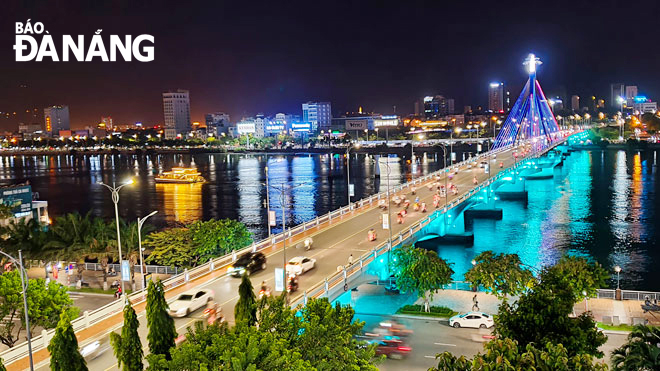Unique swing bridges in Viet Nam
Vietnamese record organization VietKings in July 2022 published the first 20 records on its inaugural list of Viet Nam’s top 100 immutable records. The immutable records, according to VietKings, are phenomena, objects, constructions, works, and events that appear or exist in Viet Nam and are nearly irreplaceable or have extremely little potential to be damaged in the future.
 |
| The Han River Cable-Stayed Swing Bridge is always the pride of Da Nang's people. Photo: DUC HOANG |
Among them is the Han River Bridge which is confirmed to be the first cable-stayed swing bridge in Viet Nam. We have to call it as the cable-stayed swing bridge because it is the fact that, more than 100 years ago, there were many unique swing bridges built by the French in Viet Nam.
Specifically, a number of swing bridges were built in the late 19th century and early 20th century in Viet Nam, such as the My Tho, Tam Bac, Bac Lieu and Khanh Hoi swing bridges.
Among them, the My Tho Swing Bridge is the oldest of its kind in Viet Nam. It spans the Bao Dinh Canal, currently connecting the Thu Khoa Huan Street, Ward No.1 to Dinh Bo Linh Street, Wards 2 and 3, My Tho City, Tien Giang Province.
The My Tho Swing Bridge connects the Old Market with the villages of Dieu Hoa, Thanh Tri, and Binh Tao in the west, thereby bringing the place to life, currently known as My Tho City.
This iron bridge was designed and built by French architect Gustave Effeil in the 1890s.
Named as swing bridge, the bridge was in fact designed and operated as a vertical lift bridge as its middle span can be vertically raised and lowered to allow ships to pass easily.
In 1938, the bridge collapsed, so it was rebuilt with reinforced concrete. In 1993, it was demolished and completely constructed, but the name ‘swing bridge’ still exists to this day.
Meanwhile, the Tam Bac Swing Bridge in Hai Phong City and the Khanh Hoi Swing Bridge in Ho Chi Minh City were built in the early 20th century.
Work started on the Tam Bac Swing Bridge across the Tam Bac River by the French in 1901 and it was then inaugurated in 1902. The bridge is made of steel, and has 2 spans and 3 navigable compartments. It is used for both road and railway. The special thing is that the middle span of the bridge rotates 90 degrees around the axis, manually controlled by a team of 5-6 Vietnamese workers.
In the past, workers had to control the pulley system to operate the middle span being about 50 meters long and weighing hundreds of tonnes to allow boats to pass. After that, the operation was switched to using the engine, but still able to use human power when needed.
In 1951, the provisional government named it Hoa Lu Bridge, after 1954 it was changed to the Tam Bac Bridge as it is today.
The Tam Bac Bridge was damaged by bombs during the war of sabotage by the US Air Force in North Viet Nam, and it was repaired later but were not able to swing again.
In 2011, in order to synchronize traffic and urban beauty, Hai Phong built the Tam Bac pedestrian bridge parallel to the old bridge which was then opened to traffic in 2013.
Meanwhile, the construction of the Khanh Hoi Swing Bridge was started in 1902. Built by the French contractor Levallois Perret, the bridge spans the Ben Nghe Canal - which was named L'Arroyo Chinois - the canal of the Chinese - by the French.
Initially, the bridge was designed with a swinging middle span for boats to pass through. In the 1940s, the bridge was fixed due to the installation of additional railway lines leading to the port.
In 1954, this bridge was demolished, rebuilt and renamed Bac Binh Vuong Bridge. When the Saigon River Tunnel was built in 2006, the Khanh Hoi Bridge was demolished again to build a new higher one which was opened in 2009. At this time, the bridge no longer connects directly to Ho Tung Mau Street but bends to directly connecting Nguyen Tat Thanh Street with Ton Duc Thang Street, along the Bach Dang Wharf.
In Bac Lieu City, in the early 1920s, there was an iron swing bridge spanning the Bac Lieu River, right in the busy trading centre. Till date, the bridge has been repaired into a reinforced concrete one and renamed after Kim Son - a place in Ninh Binh that is a twin locality with Bac Lieu Province.
The construction of swing bridges built in the late 19th century and early 20th century met the needs of trade when waterway transport prevailed.
In particular, the Tam Bac Swing Bridge ensures traffic on the Hai Phong - Hanoi - Lao Cai railway and road, and waterways from the seaport to the inland. The Khanh Hoi Swing Bridge was opened to ensure traffic for Ben Thanh and Cho Lon market areas, even though there was the Mong Bridge spanning the Ben Nghe River before.
Over the past time, the aforementioned swing bridges have been repaired into reinforced concrete ones, but they still keep the function of connecting the two riverbanks and their names in residents' memories.
Thanks to its own uniqueness, the Han River Cable-Stayed Swing Bridge is always the pride of the people of Da Nang, and a symbol of consensus and vitality of the dynamic and creative city in Central Viet Nam.
Reporting by ANH QUAN - Translating by M.DUNG